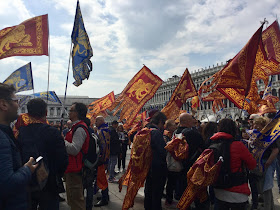 |
| April 25 - Piazza San Marco - Photo: Cat Bauer |
On Saint Mark's day, men give a single rose to women they love. This tradition, the Festa del Bocolo, originated in the eighth century -- long, long before Liberation Day -- when the daughter of the Doge fell in love with a troubadour. Seeking to overcome the class difference and prove his worth, the troubadour went off to war. He was mortally wounded, but plucked a rosebud before he died, entrusting it to his comrade to give to his beloved. I wrote a detailed post about it in 2014, when a thousand Venetian residents formed a human rose in Piazza San Marco, which you can read here:
More Venetians than Tourists in Piazza San Marco and Open Arsenale
The flag that you see fluttering from balconies all over Venice -- the flag that waves in Piazza San Marco itself -- is the red and gold flag with the winged lion of San Marco holding an open book. The words say: "Pax tibi Marce, evangelista meus," or "Peace be with you Mark, my evangelist." The winged lion is a symbol of St. Mark, and the open book signifies that Venice is at peace.
There is another red and gold flag, one with the winged lion holding a sword. This supposedly signifies that Venice is at war. (Or that it is angry:-)
Every year on April 25, Venetians, most from the Veneto, make the journey to Piazza San Marco to wave their flags. The local press labeled them the "nostalgic" group. This year when I arrived in Piazza San Marco, there was a new blue and gold flag on the scene with the winged lion holding an open book. I asked some
Venetians what it signified. They said it was the flag of the land,
whereas the red flag was the flag of the sea.
None of those interpretations are official.
 |
| April 25 - Piazza San Marco - Photo: Cat Bauer |
Everything was peaceful in the piazza, with people milling around as some musicians from La Fenice on stage cranked into Vivaldi. Then, from the distance, shouting was heard and a new group waving more portentous flags poured into Piazza San Marco from the XXII Marzo entrance. Their flags portrayed the winged lion wearing a black hood and holding a sword. They took over the center of the piazza, causing all sorts of commotion.
By this time, I was completely bewildered as to what was going on, and which flag signified what (I am on the Festa del Bocolo team:-). The blue and red flags seemed to get along, but this new hooded flag was greeted with shouts of "Fuori! Fuori!" "Out! Out!" I asked a man holding a red flag what the hooded flag meant, and he called them communists. Later, one local paper called them the "no-global" group; another paper described the lion as wearing a Zapatista, a symbol of resistance. Shouting ensued, but no one was violent. A handful of riot police arrived wearing blue helmets and jackets; they weren't those scary all-in-black police; they almost seemed to be enjoying themselves.
 |
| Police in Piazza San Marco - April 25 - Photo: Cat Bauer |
Next, drums could be heard in the distance. This time, through the XXII Marzo entrance came soldiers wearing old-fashioned uniforms and carrying rifles with bayonets. Here comes the Cavalry! The soldiers marched around Piazza San Marco, then straight through the center of the hooded flags, who parted peacefully.
Then the Consigliere alle Tradizioni Giusto, which translates to something like the "Advisor of Correct Traditions" and Luigi Brugnaro, the Mayor of Venice, came on the stage to address the crowd. The basic message was that classic music speaks the language of everyone. That Venice was a great city open to everyone, liberated for everyone. At that point, the crowd was no longer agitated, but enthusiastic.
Then, the musicians from La Fenice kicked again into Vivaldi, and the band played on.
Ciao from Venezia,
Cat Bauer


In Italy, April 25 is a national holiday, Liberation Day, commemorating the end of the Italian civil war, and honoring the Italian troops that fought against Mussolini and the Fascists (Italy) and the Nazis (Germany), during World War II, putting it very simply. In Venice, it is something more: it is also the Feast of Saint Mark, Venice's patron saint. It is a politically charged day in Venice because many people in the Veneto region wish to be autonomous, which has been labeled a "Venexit." Others are more moderate, and simply wish to preserve the Venetian culture and language. So all sorts of elements get tangled up together.
ReplyDelete